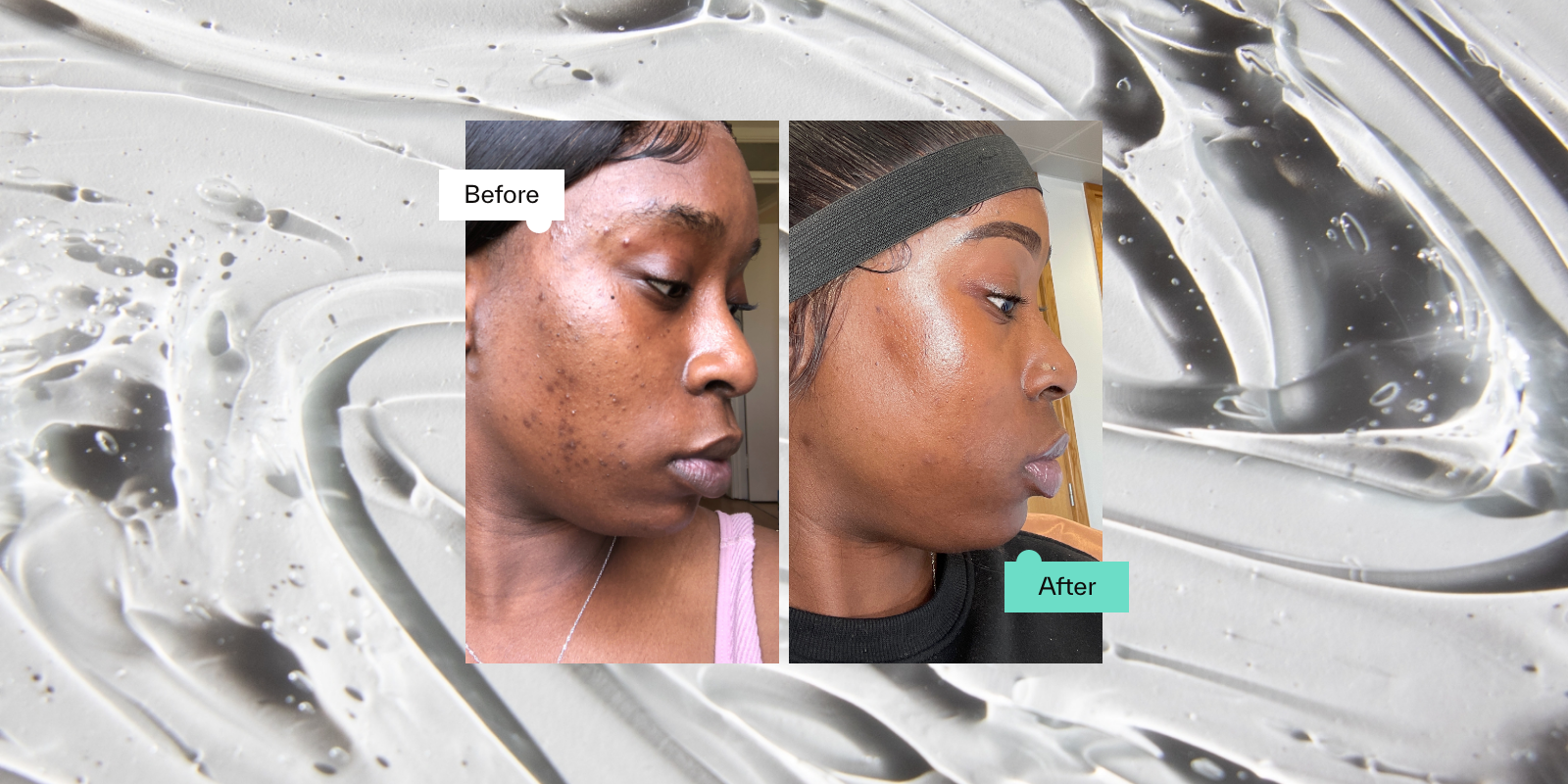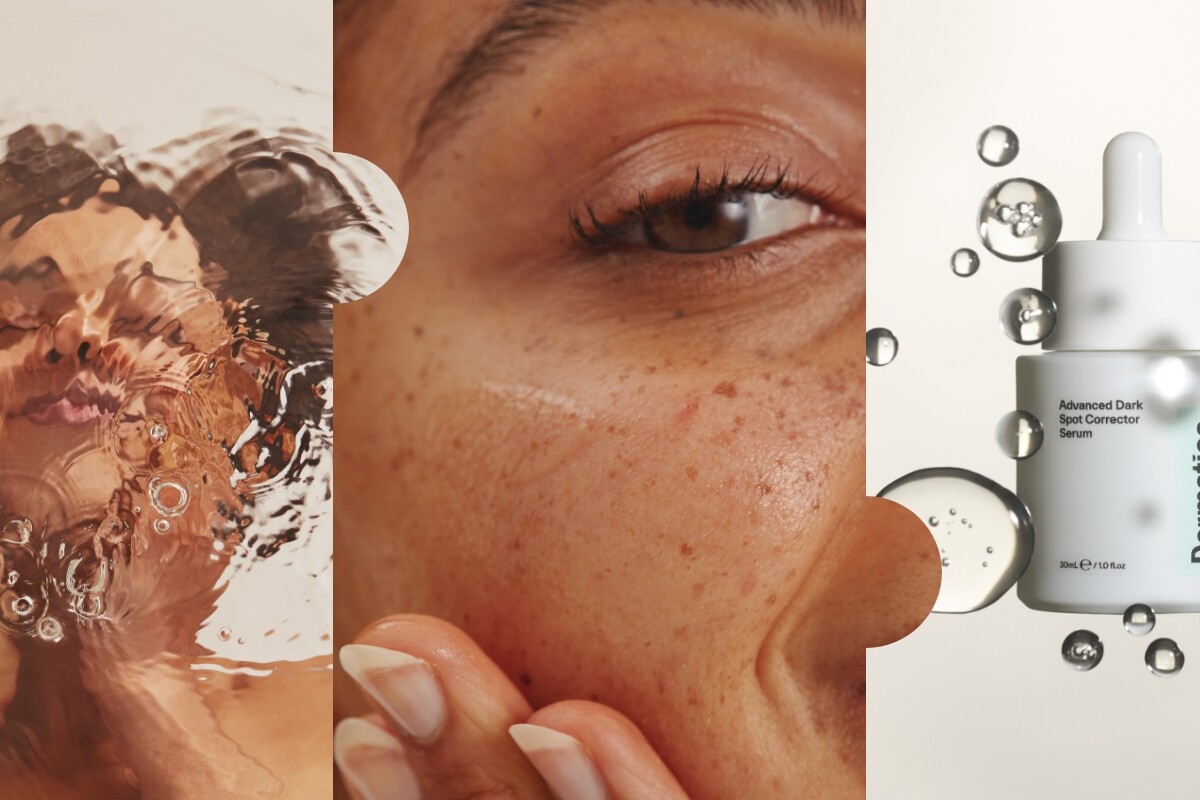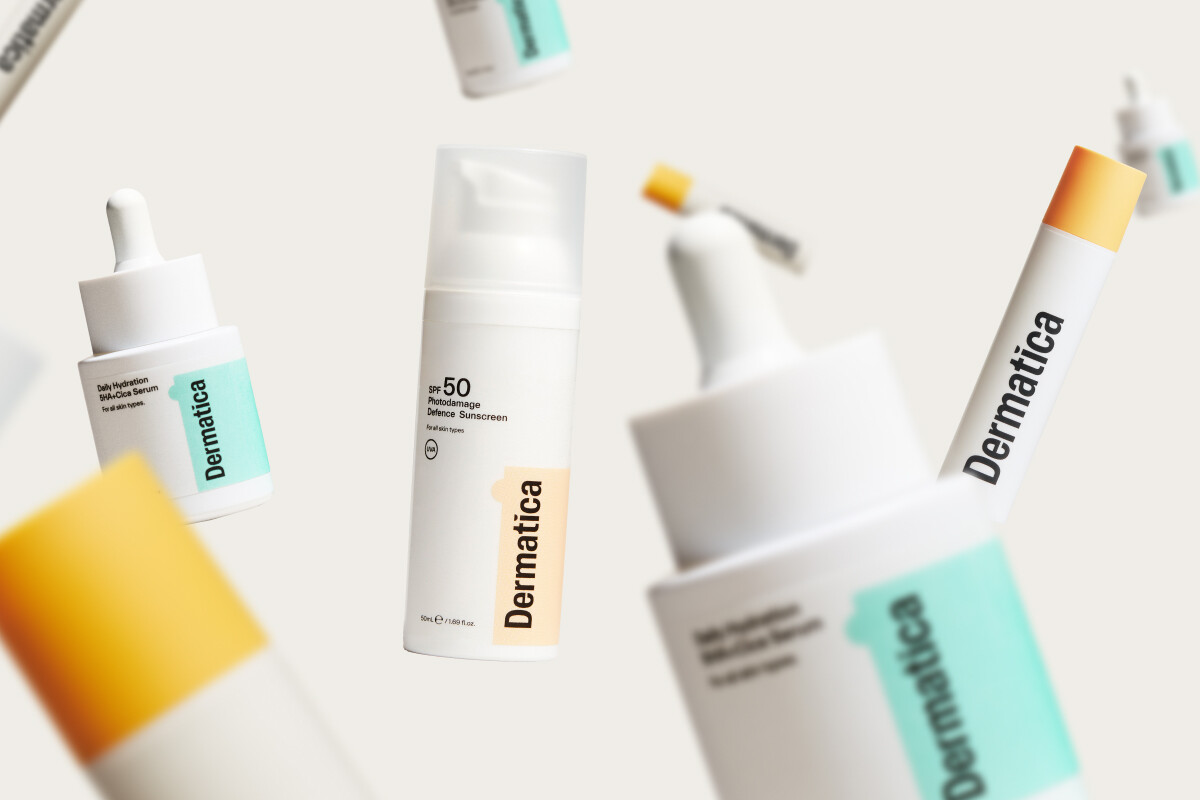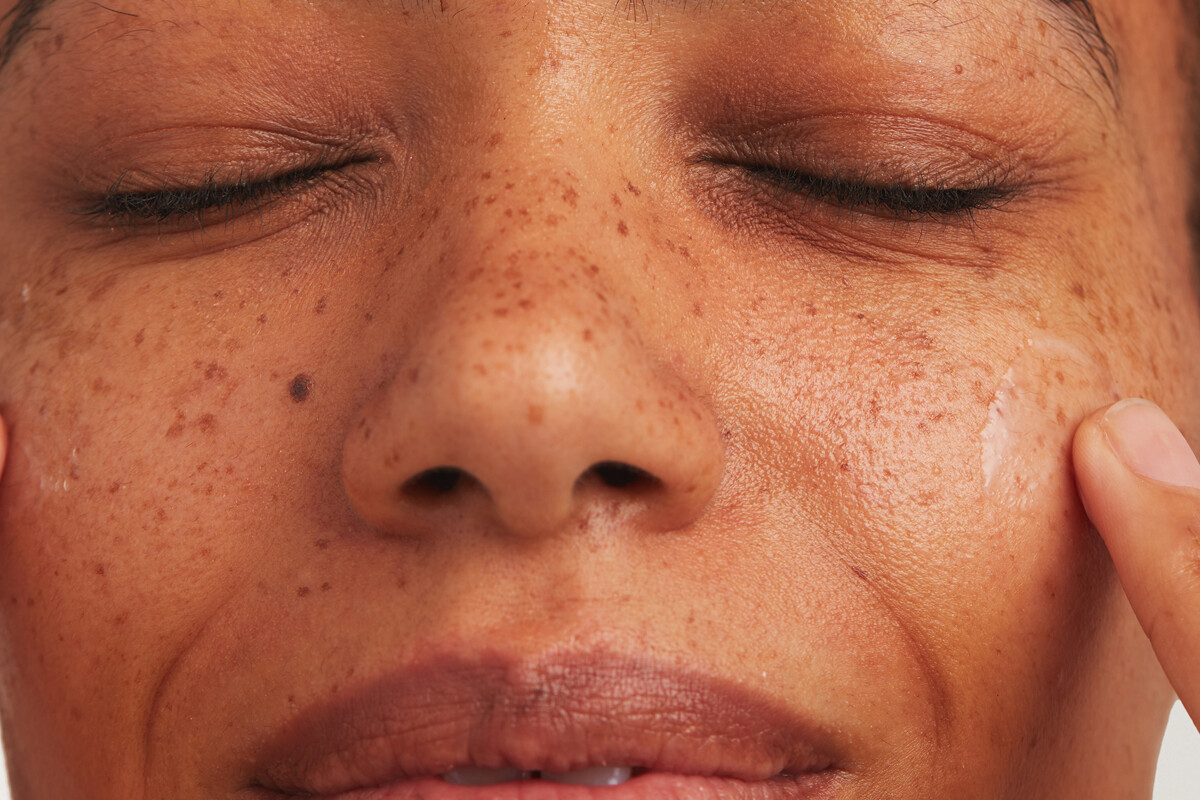If you’ve stuck to a basic oil-free skincare routine, but you’re still finding that your acne symptoms won’t ease, it might be time to speak to a dermatology professional about your symptoms.
Breakouts affect around 65% of us. Although they don’t bother everyone, there’s no shame if your confidence takes a dive when you’re experiencing an acne flare-up. If this sounds like you, just know there are other – more effective – options out there. (1) Adapalene is a topical retinoid that’s best known as a gold standard treatment for acne breakouts. Many acne patients have seen noticeable improvements in their skin after starting a personalised treatment plan with prescription-strength adapalene as the key ingredient.
If you’re curious about the before and after effects of adapalene, and whether a dermatology professional may recommend it for your skin, we’ll be exploring what skin conditions respond best to it, how your skin will feel after you start it, and how this medication could reduce your symptoms and promote a healthier complexion long term.
How Adapalene Works
Adapalene has a multitude of benefits and is often recommended by dermatologists as a first-line treatment for acne symptoms. It increases cell turnover, unclogs pores and prevents new comedones and spots from forming. By treating acne at the source, adapalene promotes a smoother complexion. It also helps lower the levels of acne-causing bacteria on the skin, calms inflammation and fades the appearance of acne scars.
If you have severe acne and/or a medium to dark skin tone, acne lesions that have healed can often leave behind dark spots called post-inflammatory hyperpigmentation. Severe acne can also cause scars and uneven skin texture. Neither of these are harmful, but they can be tricky and stubborn to treat. By accelerating the rate of healthy skin cell turnover, adapalene removes dead cells from the surface of the skin and stimulates the growth of new, healthy cells. This can help smooth and even out the look of uneven skin tone and texture and stop new scars from forming.
Adapalene has decades of research and evidence behind its benefits. It’s been prescribed to over 40 million people over the past 20 years. (2)
More Benefits Of Adapalene
1. It’s more stable in sunlight than other topical retinoids. Some prescription retinoids such as tretinoin or tazarotene become deactivated under UV light –– making them less effective.
2. Adapalene can also treat photoageing. Its ability to exfoliate and reduce inflammation helps fine lines appear smoother and less pronounced. It also helps even out hyperpigmentation. (3)
3. It can be used as a long-term, maintenance treatment for moderate acne, chronic acne or inflammatory acne.
Is Adapalene Suitable For Sensitive Skin?
Yes. Since patients with acne can also have highly sensitive or reactive skin, adapalene is often a dermatology expert’s first choice for acne treatment. Various studies suggest that adapalene is the best prescription-strength retinoid for sensitive skin because it causes fewer side effects. Adapalene is also less likely to bring about skin irritation compared to other retinoids or medications that treat acne. Plus, one of its key benefits is that it has an anti-inflammatory effect on active breakouts and painful pustules (also known as pimples). (4)
Adapalene For Acne
What Is Acne?
Acne can range between mild, sporadic outbreaks of comedones (whiteheads and blackheads), to severe, cystic and sometimes painful pustules. Spots appear because a pore becomes blocked with excess skin cells and sebum (oil). You’ll usually notice oily skin, which often looks congested, red or swollen, with hard lumps that build up beneath the surface. It’s common in adolescents, but the symptoms can also return or persist in adulthood.
Because acne causes an inflammatory reaction in the skin, it can also cause post-inflammatory hyperpigmentation. This is characterised by dark spots left behind from the original acne lesion. In some cases, acne can also leave permanent scars such as icepick, rolling or box scars. (5)
Causes and Triggers of Acne
Acne is caused by clogged pores. Hormones are the most common trigger of adult acne. Fluctuating hormone levels can happen due to menstruation, pregnancy, menopause, and birth control pills.
Hormonal changes can affect how much sebum (oil) your skin produces. The sebum interacts with bacteria on the pores of your skin, leading to acne breakouts in some people.
Clogged pores can therefore be caused by:
– Excess sebum (this is the oil secreted from sebaceous glands in the middle layer of skin).
– Acne-causing bacteria.
– Dead skin cells.
Adult acne can also be triggered by genetics. If you have a strong family history of adult acne, you may be more prone to it. (6)
Managing Acne Symptoms During Adapalene Treatment
Using the wrong skincare, or textures that are too heavy for your skin type, can trigger an outbreak of spots. Take a look at any new products you may have added to your routine, such as makeup, haircare or skincare. They may house comedogenic (pore-clogging) ingredients. Products containing coconut oil, olive oil, mineral oil, jojoba oil, petrolatum and silicones should be avoided.
Granular or sandy exfoliants should also be stripped from your routine completely. Physical scrubs can aggravate and damage your skin barrier, as well as spread acne-causing bacteria, all of which can worsen breakouts. Topical retinoids are a more effective alternative to these, as they target acne symptoms at the source.
Diet and stress may also affect how often you break out. If your skin goal is clearing acne, some studies show that having sugary products, high glycemic foods, whey protein and milk may be making your acne worse but more evidence is needed on this. (7)
Before Starting Adapalene Treatment
Before you start using adapalene, we highly recommend checking in with a dermatology professional to make sure you’re using the correct dosage for your skin type, skin condition, and where you are on your skin journey. This will help prevent severe irritation, retinisation or side effects.
Adapalene Treatment Duration and Expectations
Although adapalene is typically less irritating than other prescription retinoids, it’s normal to notice a few unwanted side effects when you first start using it.
These side effects include redness (for white or lighter skin tones), irritation or purging. Purging is when a person may experience temporary new breakouts or the worsening of existing breakouts.
When Does Purging Start?
Purging is normal when you’re just starting to use topical retinoids like adapalene, when you’re switching from one active ingredient to another, or when you’re increasing the strength. It means that the active ingredients are starting to work. It’s important to know that not everyone experiences side effects when they first start using treatment, but that doesn’t mean that the active ingredients aren’t working.
Purging symptoms usually start at 1-2 weeks. You may see redness, irritation or purging as your skin adapts to your new topical retinoid.
You may also experience purging if you change from one active ingredient to another, for example if your dermatology expert switches your the main ingredient in your personalised formula from tretinoin to adapalene.
During the first few weeks, you might notice that your breakouts temporarily get worse before they get better. (8)
Managing Side Effects During Treatment Of Acne
Common side effects you might experience when you first start adapalene include dryness, redness (for light to medium skin tones), peeling and irritation. Here are our expert tips to manage these side effects.
– Start slowly. If you’re worried about side effects, apply your adapalene treatment every other night. You can gradually increase how often you apply it as your skin gets used to the medication.
– Moisturise. Use a fragrance-free moisturiser that is specifically formulated to use alongside active ingredients. Apply it before and after you apply your personalised adapalene treatment to decrease the risk of irritation to your skin barrier.
– Use a gentle cleanser. Skin products like a mild, non-foaming cleanser that’s alcohol and fragrance- formulated in accordance with the NICE guidelines.
After: What To Expect From Your Acne Treatment
How Long Does It Take To See Results?
Although some may start to see improvements in their skin after 6-8 weeks of treatment, most people see results from adapalene treatment after 8-12 weeks. This will depend on your skin type, how consistently you use your treatment and how your individual skin responds to the active ingredient.
By Week 12 you should see a significant reduction in your acne symptoms. We always recommend that you continue to use your treatment every day, even after your symptoms have faded, to restore your skin tone and texture, keep pores clear and prevent any more breakouts.
Tips For Enhancing The Effects Of Adapalene
Building A Skincare Routine Around Adapalene
Acne can affect all skin types, including dry skin. You therefore don’t want to be using harsh or stripping products. Instead, choose skin products that are gentle and formulated according to the NICE guidelines for sensitive skin. You want products that are non-comedogenic, oil free and fragrance free to prevent your pores from clogging. Steer away from facial oils and heavy creams.
Here is the routine our dermatology experts at Dermatica recommend.
Products For Acne You Can (And Should) Keep In Your Routine
Cleanse: Balancing Glycerin Gel Cleanser
Formulated according to the NICE guidelines for sensitive skin, this lightweight and hydrating cleanser gently removes light makeup, dirt and impurities without stripping the natural skin barrier. Use twice a day, morning and evening.
Treat: Hydrating Hyaluronic Acid + Vit B5 Serum
Featuring two molecular weights of hyaluronic acid, this ultra-hydrating serum suits all skin types and conditions. Vitamin B5 also helps lock in moisture while preventing trans epidermal water loss, to protect and nourish your skin barrier. Use it on clean skin, before applying your adapalene treatment and moisturiser.
Moisturise: Soothing Centella Gel Moisturiser
Centella asiatica is a hero ingredient for those with sensitive, acne-prone or reactive skin. When formulated with ceramides and peptides, it hydrates, calms and soothes irritated and blemish-prone areas while protecting your skin barrier. Apply it after your adapalene treatment. If you’re experiencing side effects, try the buffer or ‘sandwich’ method.
Protect: SPF50 Photodamage Defence Sunscreen
A weightless, fragrance-free sunscreen that absorbs quickly is best for your skin type. With a protection factor of 50, this sunscreen shields your skin from up to 98% of harmful UV rays while using active ingredients like adapalene. Sunscreen also helps prevent inflammation as well as post-inflammatory hyperpigmentation. The streak-free formulation leaves no white residue behind, so it sits well under makeup. Always apply broad-spectrum sunscreen in the morning before going outside.
Pairing Adapalene with Other Acne Ingredients
Many ingredients can treat acne, but you may want to be careful about which ingredients you can mix with adapalene. Overloading your face with too many products can lead to skin irritation.
When you’re first starting adapalene treatment, you may want to consult a dermatology expert before combining it with:
– Vitamin C
– Benzoyl Peroxide
– Alpha hydroxy acids (AHAs) like glycolic acid and lactic acid
– Beta hydroxy acid (BHAs) like salicylic acid
– Over-the-counter retinol and other prescription or topical retinoids
– Azelaic acid
Once your skin gets used to adapalene and you’re no longer experiencing side effects, you can slowly add these ingredients back into your routine (one by one, not all at once!). If you can, ask your dermatologist or dermatology expert whether it’s suitable to do so at that stage in your journey.
How To Know If You’re Allergic To Adapalene (And It’s Not Just Side Effects)
Allergies to adapalene are very rare, but not unheard of. They’re typically more severe than side effects. Here are the key signs and symptoms to watch out for.
– Severe skin reactions. Hives, swelling, severe redness and peeling that are all more intense than typical side effects are considered an allergic reaction. If your skin begins to blister or burn, stop using your product and get in touch with your prescriber for advice.
– Respiratory symptoms. In rare cases, adapalene can cause shortness of breath, wheezing and throat tightness. If you experience this, discontinue use immediately and get medical attention.
– Fever, dizziness or fainting. If you have unexplained fever or chills, or you feel lightheaded or like you’re about to pass out, you may be having an extreme allergic reaction called anaphylaxis. If this happens, seek medical attention immediately. (2)
How To Try Adapalene
Adapalene is available over the counter in both the UK and the United States, so if you want to start using it immediately, picking it up from your local pharmacy could be a cost-effective option – especially if your acne symptoms are mild.
However, over-the-counter products aren’t tailored to your skin’s needs. To avoid unnecessary irritation, or to make sure your skincare routine is personalised to your skin type, you may want to opt for ongoing professional guidance and adjustments based on your skin’s response.
At Dermatica, we offer personalised treatment plans and skincare formulas that combine multiple active ingredients, chosen and precisely measured to suit your skin. This can often be more effective than using a single over-the-counter product.
We treat all grades and forms of acne, no matter the severity. Your treatment plan is developed based on a skin analysis, and your progress is monitored by our team of dermatology experts. We also provide ongoing support, product recommendations and formula adjustments whenever you need it. Find out what formulas are suitable for your skin by visiting our website.
Image Reference
Abigail, Dermatica Customer
Treatment: Adapalene, Niacinamide, Azelaic Acid, 7 months
References
1. Tasoula E, Gregoriou S, Chalikias J, Lazarou D, Danopoulou I, Katsambas A, et al. The impact of acne vulgaris on quality of life and psychic health in young adolescents in Greece: results of a population survey. Anais Brasileiros de Dermatologia. 2012 Dec;87(6):862–9.
2. Tolaymat L, Dearborn H, Zito PM. Adapalene [Internet]. PubMed. Treasure Island (FL): StatPearls Publishing; 2024 [cited 2024 Jun 11]. Available from: https://www.ncbi.nlm.nih.gov/books/NBK482509/
3. Rusu A, Tanase C, Pascu GA, Todoran N. Recent Advances Regarding the Therapeutic Potential of Adapalene. Pharmaceuticals [Internet]. 2020 Sep 1 [cited 2021 Feb 5];13(9):217. Available from: https://www.mdpi.com/1424-8247/13/9/217/htm
4. Baldwin H, Tan J. Effects of Diet on Acne and Its Response to Treatment. American Journal of Clinical Dermatology [Internet]. 2020 Aug 3;22(1). Available from: https://www.ncbi.nlm.nih.gov/pmc/articles/PMC7847434/
5. Kraft J, Freiman A. Management of acne. Canadian Medical Association Journal [Internet]. 2011 Feb 28;183(7):E430 Available from: https://www.ncbi.nlm.nih.gov/pmc/articles/PMC3080563/
6. Bagatin E, Freitas THP de, Rivitti-Machado MC, Ribeiro BM, Nunes S, Rocha MAD da. Adult female acne: a guide to clinical practice. Anais Brasileiros de Dermatologia [Internet]. 2019 Feb;94(1):62–75. Available from: https://www.ncbi.nlm.nih.gov/pmc/articles/PMC6360964/
7. Piskin S, Uzunali E. A review of the use of adapalene for the treatment of acne vulgaris. Therapeutics and Clinical Risk Management [Internet]. 2007 Aug 1;3(4):621–4. Available from: https://www.ncbi.nlm.nih.gov/pmc/articles/PMC2374937/
8. Retinoid-Induced Flaring in Patients with Acne Vulgaris: Does It Really Exist? The Journal of Clinical and Aesthetic Dermatology [Internet]. 2008 May 1;1(1):41–3. Available from: https://www.ncbi.nlm.nih.gov/pmc/articles/PMC2989803/
Cat Hyatt
Dr Cat Hyatt is a GP, working as Clinical Content Lead for Dermatica. She has a special interest in medical content and making healthcare information accessible and understandable for all.





